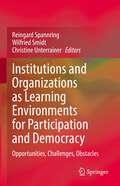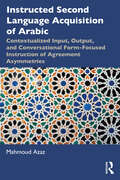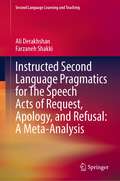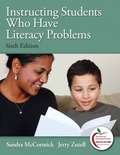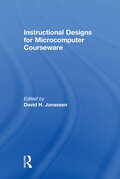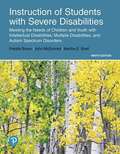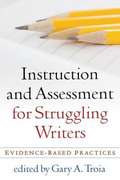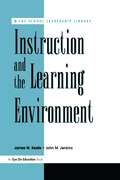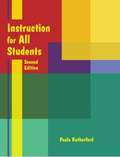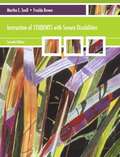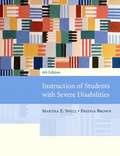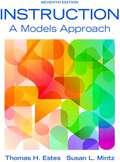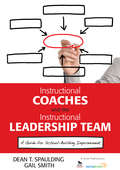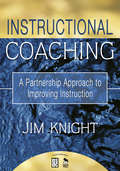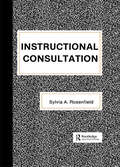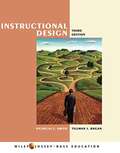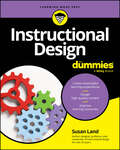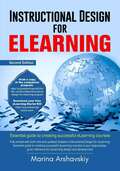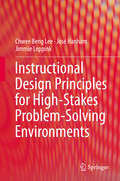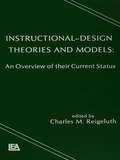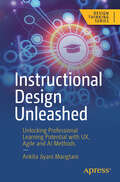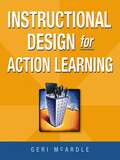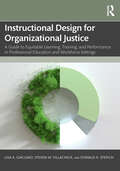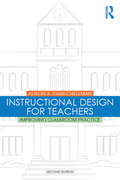- Table View
- List View
Institutions and Organizations as Learning Environments for Participation and Democracy: Opportunities, Challenges, Obstacles
by Wilfried Smidt Reingard Spannring Christine UnterrainerThis book discusses opportunities and limitations to democratic participation in institutions and organizations across the life course. It demonstrates that democratic participation is not something that is learned once and for all and applied in formal political settings, but something that is lived every day throughout life in various contexts. Institutions and organizations frame human lives and strongly determine the ability to participate and co-determine their communities. They are places for learning, deliberation and the development of the common good. The book conceptually and empirically analyses the potential of democratic participation within various institutions. The contributions range from early childhood institutions, schools, youth programs, workplaces, and vocational education to cultural organizations and nursing homes for the elderly. The book thereby provides a cross-sectional and interdisciplinary knowledge base to inspire future research and practical efforts to promote democratic participation within and across institutions around the world.
Instructed Second Language Acquisition of Arabic: Contextualized Input, Output, and Conversational Form-Focused Instruction of Agreement Asymmetries
by Mahmoud AzazInstructed Second Language Acquisition of Arabic examines the acquisition of agreement asymmetries in the grammatical system of Arabic as a second/foreign language through the lens of instructed second language acquisition. The book explores how to improve the processes of L2 learning of Arabic using evidence-based classroom research. Before it does this, it characterizes the variable challenges that English L2 learners of Arabic face when they acquire four structural cases in Arabic grammar that entail agreement asymmetries. Using the pretest–posttest design, it examines the effects of four classroom interventions using quantitative and qualitative measures. In these interventions, form-based and meaning-based measures were used to reveal to what degree learners have developed explicit and implicit knowledge of these aspects of asymmetry. In the concluding chapter, the book provides focused and specific implications based on the results of the four studies. It provides theoretical implications that enrich the discussions of instructed second language Acquisition in Arabic and other languages more broadly. It also provides implications for teachers, curriculum designers, and textbook writers of Arabic. This book will be informative for Arabic applied linguists, researchers of Arabic SLA, Arabic instructors (at the K–12 and the college level), and Arabic program directors and coordinators. The book will also appeal to all SLA and ISLA researchers.
Instructed Second Language Pragmatics for The Speech Acts of Request, Apology, and Refusal: A Meta-Analysis (Second Language Learning and Teaching)
by Ali Derakhshan Farzaneh ShakkiPragmatic instruction has received momentous attention in Second Language Acquisition (SLA) over the last decades. In order to scrutinize the effectiveness of L2 instruction, meta-analyses are warranted; nonetheless, meta-analyses have been largely neglected, despite the fact that they provide a systematic explanation of the findings from the previous studies. Since meta-analysis is flourishing by leaps and bounds in each and every field, pragmatic studies are not the exception, and among miscellaneous constructs and units of analysis in pragmatics, the speech acts of request, apology, and refusal are investigated in this book. To bridge this gap, this book mainly presents the variables which can moderate the effectiveness of L2 instruction such as age, gender, proficiency, outcome measures, psycholinguistic features, research design, and treatment types. The first chapter of the book outlines the theoretical underpinnings of the study, accentuating the importance of conducting meta-analysis in this field of study. The second chapter elaborates on the empirical studies and a thorough review of the relevant research. The third chapter deals with the design of the study in which the inclusion and exclusion criteria, effect size calculation, coding of the variables, and reliability have been outlined while chapter four presents the obtained outcomes and results of the study. The last chapter describes the final remarks of the study, the limitations, implications, and the directions for future research in the field of pragmatics instruction.
Instructing Students Who Have Literacy Problems (6th edition)
by Jerry Zutell Sandra MccormickThis research-based book on assessment and instruction of struggling readers covers both assessment and instructional strategies and reflects a balanced view of literacy instruction. Four complete chapters on formal and informal assessment, plus chapters on instructional interventions, including reading instruction for special populations, allow professors the option of using the book for one inclusive course, or, using it across two courses where diagnosis and instruction are taught separately.
Instruction Design for Microcomputing Software
by David H. JonassenSelected as one of the outstanding instructional development books in 1989 by the Association for Educational Communications and Technology, this volume presents research in instructional design theory as it applies to microcomputer courseware. It includes recommendations -- made by a distinguished group of instructional designers -- for creating courseware to suit the interactive nature of today's technology. Principles of instructional design are offered as a solid base from which to develop more effective programs for this new method of teaching -- and learning.
Instruction Of Students With Severe Disabilities
by Fredda Brown John McDonnell Martha SnellIn this authoritative guide, leading scholars and researchers present information and evidence-based practices for dealing with the full range of curriculum and instruction for individuals with severe intellectual disabilities and autism. Case studies throughout Instruction of Students with Severe Disabilities look at students of various ages and with a variety of disabilities, and each chapter includes an application to a student with autism. The content is presented with citations of supportive research, and evidence-based practices are presented in clearly defined ways to ensure that teachers understand the practices and how to apply them in their own classrooms.
Instruction and Assessment for Struggling Writers
by Gary TroiaThis unique book focuses on how to provide effective instruction to K-12 students who find writing challenging, including English language learners and those with learning disabilities or language impairments. Prominent experts illuminate the nature of writing difficulties and offer practical suggestions for building students' skills at the word, sentence, and text levels. Topics include writing workshop instruction; strategies to support the writing process, motivation, and self-regulation; composing in the content areas; classroom technologies; spelling instruction for diverse learners; and assessment approaches. Every chapter is grounded in research and geared to the real-world needs of in-service and preservice teachers in general and special education settings.
Instruction and the Learning Environment
by John Jenkins James KeefeFor leaders of elementary, middle, or high schools, this book shows how your school can excel in reaching students with diverse learning styles; providing "authentic" instruction and performance assessment; applying constructivist learning methodologies; and enhancing learning through alternative scheduling.
Instruction for all Students: Second Edition
by Paula RutherfordThe second edition of this popular book is updated to reflect current research about best practice in teaching and learning in standards-based classrooms. In addition to resources for actively engaging students and multiple approaches to lesson and unite design, this text includes information on technology integration, formative assessment, 21st century thinking skills that promote rigor and relevance, and formats for job-embedded learning.
Instruction of Students with Severe Disabilities
by Martha E. Snell Fredda BrownThe seventh edition of this widely-adopted text for special educators addresses the full-range of curriculum and instructional topics involved in educating individuals with moderate, severe, and multiple disabilities. Evidence-based practices are presented in clearly-defined ways so that teachers can easily understand the research presented and apply it in the real classroom. All chapters in the book are unique, written by leaders in the field known for their research and writing on the specific topics. Case studies of students are applied to chapter content in vignettes, tables, and figures found throughout the chapters, and the textbook rests on a solid evidence-base with research citations provided. The new edition features many new updates including: a greater emphasis on teaching students with autism; six new chapters authored by experts in the field; more information on teaching methods supported by research, peer support, teaching academic skills, the process for planning and implementing instruction within general education classrooms, transition planning, and alternate assessment.
Instruction of Students with Severe Disabilities
by Martha E. SnellThis book examines the principles behind teaching students with severe and multiple disabilities. This edition includes a stronger focus on positive behavior interventions and supports, and additional strategies on peer relationships.
Instruction: A Models Approach , Seventh Edition
by Thomas H. Estes Susan L. MintzPre-service, beginning, and experienced teachers alike can turn to this comprehensive resource for help in expanding their instructional repertoires through instructional models presented within a standards-based and instructionally aligned process. The authors present 10 evidence-based instructional models and their variations offering a range of cognitive approaches to instruction creative, compliant, collaborative, competitive, inductive, deductive, concrete, and abstract. Each model is discussed using helpful elementary and secondary examples, a variety of academic content areas, detailed steps for implementation, and a look at the demands on students. The new edition of Instruction: A Models Approach includes several features that support the development of instructional skills: chapters move from concrete models to abstract (simple to more complex) to build a clearer understanding of the ideas, video examples, and instructional strategies illustrate the concepts, and extension activities offer practice with important new information and skills. The result is a classroom-ready resource that makes instructional models clear and relevant for readers within a standards-based and instructionally aligned process. The Enhanced Pearson eText features embedded video and internet resources.
Instructional Coaches and the Instructional Leadership Team: A Guide for School-Building Improvement
by Dean T. Spaulding Ms Gail M. SmithSupercharge school improvement with instructional coaches! How can coaches seamlessly integrate themselves into the fabric of a school and help teachers improve their practice from day one? This unique companion provides an inside look at the day-to-day work of an instructional coach and offers field-tested activities, materials, and data collection forms for coaches and instructional leadership teams. The authors address common challenges, including: <p><p> Observing classrooms and providing formative feedback; Reaching out to the hesitant or resistant teacher; Adapting data and analysis into usable information for the team; Recruiting, training, and supporting new instructional coaches.
Instructional Coaching: A Partnership Approach to Improving Instruction
by Jim KnightAn innovative professional development strategy that facilitates change, improves instruction, and transforms school culture! Instructional coaching is a research-based, job-embedded approach to instructional intervention that provides the assistance and encouragement necessary to implement school improvement programs. Experienced trainer and researcher Jim Knight describes the "nuts and bolts" of instructional coaching and explains the essential skills that instructional coaches need, including getting teachers on board, providing model lessons, and engaging in reflective conversations. Each user-friendly chapter includes: <p><p> First-person stories from successful coaches <p> Sidebars highlighting important information <p> A "Going Deeper" section of suggested resources <p> Ready-to-use forms, worksheets, checklists, logs, and reports
Instructional Consultation (School Psychology Series)
by Sylvia RosenfieldRecent changes in policy and law, along with advances in research, are making it necessary for an increasing number of school psychologists, special educators, and teacher consultants to develop skills in areas other than psychoeducational assessment. In response to this need, many professionals and students are expanding their careers to include the field of instructional consultation -- the synthesis of school- based consultation techniques and a solid knowledge of effective instructional practices. This book examines the major themes of instruction and gives a step-by-step outline of the consultation process from referral to the final report. Recent changes in policy and law, along with advances in research, are making it necessary for an increasing number of school psychologists, special educators, and teacher consultants to develop skills in areas other than psychoeducational assessment. In response to this need, many professionals and students are expanding their careers to include the field of instructional consultation -- the synthesis of school- based consultation techniques and a solid knowledge of effective instructional practices. This book examines the major themes of instruction and gives a step-by-step outline of the consultation process from referral to the final report.
Instructional Design
by Patricia L. Smith Tillman J. RaganA well-documented, theory-based treatment that focuses on instructional design’s application to industry and K-12 education. Offers extensive procedural assistance, emphasizing the foundations and first principles upon which most of the models and procedures in the field are built. An Extended Example (now online) showcases applications of concepts and techniques using a single subject area and course (Digital Photography).
Instructional Design For Dummies
by Susan M. LandThe streamlined, simplified, beginner-friendly introduction to instructional design Instructional Design For Dummies will teach you how to design and build learning content to create effective, engaging learning experiences that lead to improved learning outcomes and skill development. This book breaks down the instructional design process into bite-sized pieces, so you can learn techniques and best practices without getting bogged down in theory. Learn about various instructional design models and frameworks, then discover the different options for designing learning experiences. Take into account learning foundations, goals, and contexts, then create stellar lessons for in-person or virtual delivery. This Dummies guide is your starting place for creating impactful courses, without the technical jargon. Learn the basics of instructional design so you can create meaningful learning experiences Discover techniques that will help you design high-quality content for any context Improve learning outcomes and deliver training content with greater efficiency Skip the complex theories and technical jargon and focus on the info you need to knowThis book is perfect for anyone who needs to develop a course, design a curriculum or training program, or provide educational content without being formally trained in instructional design. It’s also a great supplement to college-level instructional design courses. Whatever you’re teaching, Instructional Design For Dummies will help you teach it better.
Instructional Design For Elearning: Essential Guide For Designing Successful Elearning Courses
by Marina ArshavskiyThis Instructional Design for ELearning handbook has been updated with the latest design principles and case studies.Fully revised with both new and updated chapters, Instructional Design for eLearning: Essential Guide for Designing Successful eLearning courses is your step-by-step, go-to reference for eLearning design and development. In this book, Marina Arshavskiy presents all the practical information in one place. This second edition includes even more content, examples, case studies, practice exercises, and assessments. You will also find checklists and templates you can immediately apply to your course design. What’s new:• Technical Training• eLearning copyright information• New chapter about Agile ELearning design and development• New information about personalized and augmented learning approaches• New and up-to-date information about eLearning tools• Assessments after each chapter• New tables and templates• Case studies that illustrate eLearning concepts in each chapter
Instructional Design Principles for High-Stakes Problem-Solving Environments
by Chwee Beng Lee José Hanham Jimmie LeppinkThis book examines the types of problems and constraints faced by specialists in the areas of security, medicine, mental health, aviation and engineering. Every day we rely on highly trained specialists to solve complex problems in high-stakes environments, that is, environments involving direct threats to the preservation of human life. While previous work has tended to focus on problem solving in a single domain, this book covers multiple, related domains. It is divided into three parts, the first of which addresses the theoretical foundations, with coverage of theories of instructional design and expertise. Part two covers the five high-stakes domains and offers directions for training in these domains. In turn, part three provides practical guidelines for instructional design in high-stakes professions, including learner analysis, task analysis, assessment and evaluation. The book is intended for a broad readership, including those who operate in high-stress, time-pressure occupations. Trainers at professional organisations can utilise the theoretical frameworks and training strategies discussed in this book when preparing their clients for complex, real-world problem solving. Further, the book offers a valuable resource for academics and graduate students, as well as anyone with an interest in problem solving.
Instructional Design Theories and Models: An Overview of Their Current Status
by Charles M. ReigeluthInstructional Design Theories and Models is a thorough yet concise overview of eight of the most comprehensive and best-known attempts to integrate knowledge about effective and appealing instruction. Chapters were written by the original theorists to provide a more accurate and behind-the-scenes look at the theories' development. Instructional Des
Instructional Design Unleashed: Unlocking Professional Learning Potential with UX, Agile and AI Methods (Design Thinking)
by Ankita Jiyani MangtaniDive into the expansive realm of instructional design and explore a rich tapestry of effective strategies and practical techniques. This comprehensive guide is a treasure trove of insights bridging the theoretical foundations of instructional design with hands-on, actionable methods to elevate learning experiences. After reviewing the fundamentals, you’ll unravel the essence of instructional design, what it entails, and how its principles can be harnessed. Your journey then delves into the scientific underpinnings of learning in professional settings, dissecting pivotal concepts such as cognitive load, cognitive load theory (CLT), learning styles, and modalities. The guide extends its reach to address inclusivity, promoting equitable practices, and mitigating unconscious bias during the design of learning courses and environments. With a solid foundation in place, you’ll examine key frameworks specific to learning and instructional design, including the tried-and-true methodologies of ADDIE, SAM, and ARCS. Going beyond the conventional, the guide widens its lens to incorporate broader methodologies, such as user-experience (UX), Agile methodologies, storyboarding, and gamification, all prevalent in the tech industry. It also delves into virtual learning environments and the nuances of creating effective online learning experiences and contemplates the revolutionary impact of generative AI on reshaping this space. With a forward-looking perspective, Instructional Design Unleashed anticipates and navigates the potential changes and innovations that AI can introduce, positioning instructional designers at the forefront of the evolving landscape of educational technology. What You’ll Learn Uncover the scientific foundations of learning and their seamless integration into the learning experience. Explore practical methodologies and techniques that can be readily applied to enhance your learning projects. Study the vast potential of generative AI within the realms of e-learning and virtual learning environments. Unlock the innovative possibilities for the future of educational technology. Who This Book Is For Instructional designers, eLearning developers, educators, trainers, app developers, UX designers, and anyone involved in creating effective learning experiences.
Instructional Design for Action Learning
by Geri McArdleThis book gives you all the guidance and exercises you need to incorporate action learning into every training you conduct.A trainer&’s job is to ensure their lessons stick, which means relating lessons to their trainees&’ own on-the-job experiences. Author Geri McArdle teaches trainers how to do this by using the strategies of &“action learning&” in their lesson design and presentation to help learners better absorb the material.Filled with examples of easy-to-implement action learning techniques, Instructional Design for Action Learning shows you how to: create fun and memorable activities that match participants&’ needs, learning styles, and levels of understanding;encourage learners to build on their own experiences;evaluate learner mastery during the entire learning event;strengthen learning transfer back on the job;and accurately measure post-training results.By providing trainers with the tools they need to make real learning happen, this essential guide strengthens the value of your program--and the job performance of those you train.
Instructional Design for Organizational Justice: A Guide to Equitable Learning, Training, and Performance in Professional Education and Workforce Settings
by Lisa A. Giacumo Steven W. Villachica Donald A. StepichInstructional Design for Organizational Justice prepares instructional designers to use culturally relevant, performance-based learning materials and environments that improve organizational and workplace learning experiences for today’s diverse, globalized contexts. With socially just leadership and DEI initiatives growing in institutions across sectors, today’s instructional design programs must prepare graduate students to be more culturally relevant, equity-minded, and inclusive in their professional practice. This textbook explores the implementation of systematic, systemic, and performance-oriented designs alongside the use of organizational justice theory to facilitate more equitable, inclusive performance improvement and workplace learning interventions.The book introduces the Learning and Performance Support Instructional Design (LeaPs ID) Model. Applicable to instructional designers, educational technologists, learning experience designers, learning engineers, and human resource development professionals, this original, iterative process: integrates common ID heuristics, design-based thinking, culture, equity, inclusion, and other inputs external to the organization and ID project; portrays a realistic, scalable, iterative, agile approach to the ID process; aids in the design of environments in which adult learners can observe, practice, and receive feedback, building the knowledge and capacity required for their desired performance; and is illustrated by a wealth of examples, templates, and processes developed in the field to support adult learners and collaborate with subject matter experts. Relevant to business, government, military, non-profit, non-governmental, and higher education settings, this unique and comprehensive volume lends itself to uncovering values and motives essential to successful agile project management as well as to diversity, equity, and inclusion initiatives and social change.
Instructional Design for Teachers: Improving Classroom Practice
by Alison A. Carr-ChellmanInstructional Design for Teachers, Second Edition focuses on the instructional design (ID) process specifically for K-12 teachers. The first edition introduced a new, common-sense model of instructional design to take K-12 teachers through the ID process step by step, with a special emphasis on preparing, motivating, and encouraging new and ongoing use of ID principles. This second edition includes new material on design in gaming, cybercharters, online classrooms, and flipped classrooms, as well as special considerations for the Common Core. Each chapter contains framing questions, common errors, easy-to-use rules of thumb, clearly stated outcomes, and examples showing ID in action. The basic model and its application within constructivism and user-design will help teachers adapt from a behavioral approach to a more open, student-centered design approach. Combining basics with strategies to implement this model in the most advanced instructional approaches, this book empowers teachers and learners to use good instructional design with the most recent research-based approaches to learning. Instructional Design for Teachers shows how ID principles can impact instructional moments in positive and practical ways. The book can be used for basic ID courses and introductory curriculum courses, and is accessible to in-service as well as pre-service teachers.
Instructional Design with Emerging Technologies: Theory, Practice, and Research
by Heng LuoBridging the gap between instructional design (ID) theory and practice in today's technology-enhanced learning environments, the book extends the current understanding of instructional science with an up-to-date perspective on emerging technologies and their affordances for teaching and learning.Positioning ID as a systematic process informed by theoretical assumptions, empirical evidence, and pragmatic considerations, this book provides an in-depth description and reflective analysis of good practice in technology-enhanced learning and design with a tripartite framework of pedagogy, technology, and evidence. It covers well-established ID theories and models with real-life examples of their effective integration with technological innovations. The book aims to advance the understanding of ID from both pedagogical and technological perspectives to improve educational practice and theory development in the information age.The book will be of interest to students and academics in educational technology, instructional science, and instructional design, as well as instructional designers and teachers.
